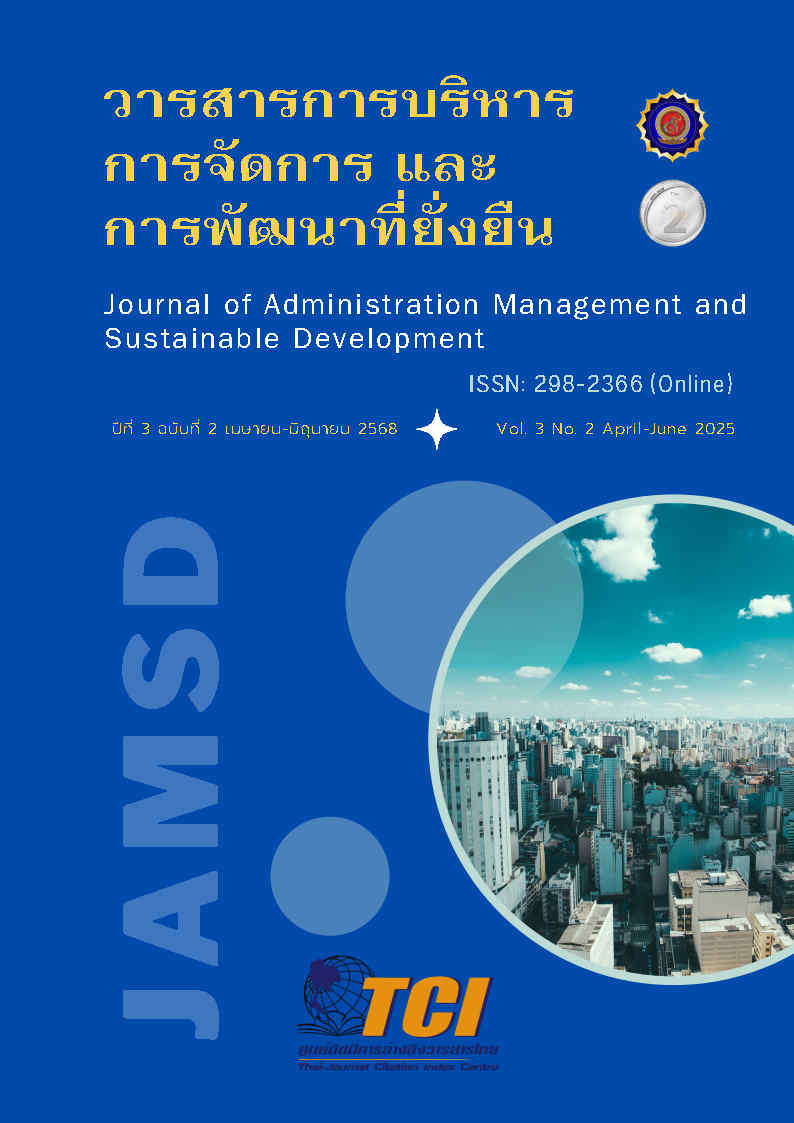The study of CSV activity format, perceived benefits, and enjoyment on the intention to recommend CSV participation activities of Government Savings Bank, Head Office, Payathai District, Bangkok
Keywords:
perceived usefulness, Creating Shared Value (CSV), entrepreneurs, street foodAbstract
The influence of CSV activity format, perceived benefits, and enjoyment on the intention to recommend CSV participation activities, to examine how CSV activity formats, perceived benefits, and enjoyment within CSV activities affect word-of-mouth intention to participate in CSV activities, and to develop appropriate CSV activity formats for street food entrepreneurs’ government savings bank head office Phayathai district, Bangkok. The sample consisted of 400 street food entrepreneurs in Government Savings Bank's operational areas, selected through proportional stratified random sampling. Data was collected using a questionnaire with an IOC value of 0.67-1.00 and reliability of 0.95. Data analysis employed mean, standard deviation, Pearson's correlation coefficient, and multiple regression analysis. The results showed that: The study of CSV activities at Government Savings Bank found that online and onsite activity formats had the highest level of implementation. Perceived benefits were at a high level, particularly in applying knowledge to business operations. Enjoyment from workshops and recreational activities received the highest scores, and intention to recommend was at a good level as participants viewed it as beneficial to society. The CSV activity formats had a moderate correlation with intention to recommend, perceived benefits had a high correlation with intention to recommend, and the onsite format had the greatest influence. All variables could explain 40.60% of the intention to recommend according to the prediction equation: Intention to Recommend = 0.908 + 0.042(Online) + 0.372(Onsite).
References
ธนาคารออมสิน. (2566). รายงานการพัฒนาอย่างยั่งยืน ประจำปี 2566. กรุงเทพฯ: ธนาคารออมสิน. https://www.gsb.or.th/csr/gsbcsr/sustainability-reposts/report/.
บุญชม ศรีสะอาด. (2565). การวิจัยเบื้องต้น (พิมพ์ครั้งที่ 8). กรุงเทพฯ: ชมรมเด็ก.
มติชนสุดสัปดาห์. (2566). ก.แรงงาน เปิดตัวโครงการส่งเสริมอาชีพ ปั้นแรงงานสู่ผู้ประกอบการร้านสตรีทฟู๊ด สร้างงานเพิ่มรายได้ กระตุ้นเศรษฐกิจ. สืบค้น 28 มีนาคม 2568 จาก https://www.matichon.co.th/weekly/pr/article_677140.
เรณุมาศ กุละศิริมา, นุจิรา รัศมีไพบูลย์, สุวรรณา พิชัยยงค์วงศ์ดี และเปรมฤทัย แย้มบรรจง. (2560). กลยุทธ์การพัฒนาแบบองค์รวมเพื่อยกระดับคุณภาพอาหารท้องถิ่นเพื่อส่งเสริมการประกอบธุรกิจร้านอาหาร/ภัตตาคารและการท่องเที่ยวอย่างยั่งยืนในเมืองพัทยา จังหวัดชลบุรี. รายงานการวิจัย. กรุงเทพฯ: มหาวิทยาลัยสวนดุสิต.
ลัดดาวัลย์ เลขมาศ และแพรวพรรณ อินทรเกษม. (2562). แนวทางพัฒนาศักยภาพผู้ประกอบการ SMEs. วารสารวิชาการมหาวิทยาลัยหอการค้าไทย (มนุษยศาสตร์และสังคมศาสตร์), 39(2), 104–122.
วรรษมล แสนทวีสุข และกนกกานต์ แก้วนุช. (2565). ปัจจัยที่ส่งผลต่อการสร้างประสบการณ์ผู้บริโภคอาหารสตรีทฟู้ดในกรุงเทพมหานคร ภายหลังการแพร่ระบาด COVID-19. วารสารมนุษยศาสตร์และสังคมศาสตร์ มหาวิทยาลัยราชภัฏสวนสุนันทา, 5(2), 7–21.
วิทวัส รุ่งเรืองผล. (2546). การวิเคราะห์และทำความเข้าใจพฤติกรรมผู้บริโภค. กรุงเทพฯ: เธิร์ดเวฟ เอ็ดดูเคชั่น.
วิทวัส รุ่งเรืองผล. (2558). ตำราหลักการตลาด (พิมพ์ครั้งที่ 9). กรุงเทพฯ: มาร์เก็ตติ้งมูฟ.
สุกัญญา รักพานิชมณี, วศินี ธรรมศิริ และสัจจา ดวงชัยอยู่สุข. (2562). ความสัมพันธ์ระหว่างผลการดำเนินงานด้านความรับผิดชอบต่อสังคมกับผลการดำเนินงานด้านการเงินของบริษัทจดทะเบียนในประเทศไทย. วารสารบริหารธุรกิจ นิด้า, 25, 140–157.
Hennig-Thurau, T., Gwinner, K. P., & Gremler, D. D. (2002). Understanding relationship marketing outcomes: An integration of relational benefits and relationship quality. Journal of Service Research, 4(3), 230-247.
Longenecker, J. G., Petty, J. W., Palich, L. E., & Hoy, F. (2016). Small Business Management: Launching & Growing Entrepreneurial Ventures (18th ed.). Cengage Learning.
Morgan, R. M., & Hunt, S. D. (1994). The commitment-trust theory of relationship marketing. Journal of Marketing, 58(3), 20-38.
Reynolds, K. E., & Beatty, S. E. (1999). Customer benefits and company consequences of customer-salesperson relationships in retailing. Journal of Retailing, 75(1), 11-32.
Richins, M. L., & Root-Shaffer, T. (1988). The role of involvement and opinion leadership in consumer word-of-mouth: An implicit model made explicit. Advances in Consumer Research, 15(1), 32-36.
Zeithaml, V. A., & Bitner, M. J. (2000). Services marketing: Integrating customer focus across the firm (2nd ed.). McGraw-Hill.






